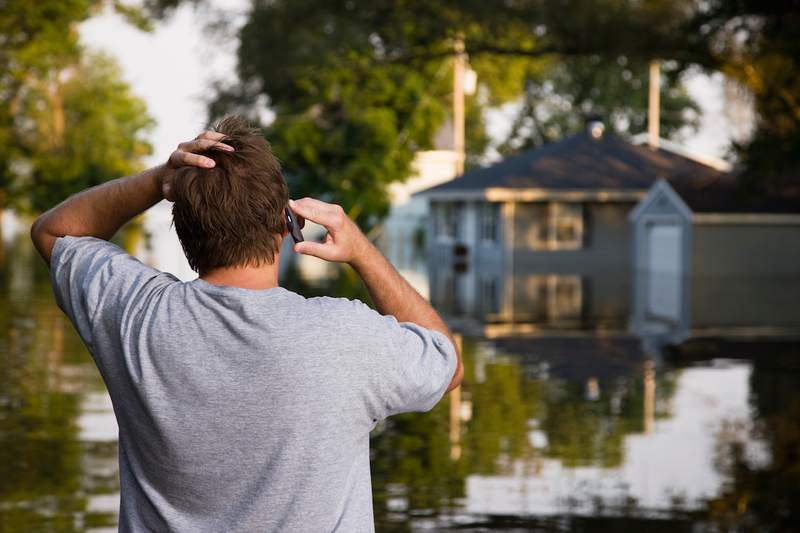It’s easy to think that your homeowners insurance policy will protect your home and its contents in any type of emergency or disaster. But that’s not always the case.
Does your home insurance cover earthquakes and floods? The answer is no — homeowners insurance policies do not cover damage caused by those disasters. Homes in places that are vulnerable to quakes and floods need separate flood and earthquake insurance policies, so failing to be properly insured can leave homeowners financially devastated.
Here’s what you need to know about earthquake and flood insurance.
Key Takeaways:
- Earthquake and flood damage typically isn’t covered by homeowners insurance policies.
- Buying these specialized coverages helps protect your home and finances, especially if you live in a high-risk area.
- In many parts of the country, earthquake or flood insurance policies are required by mortgage lenders.
What Is Earthquake Insurance?
An earthquake is a sudden and violent shaking of the ground caused when two plates in the Earth’s crust scrape against one another, or by volcanic action.
How common are earthquakes? The Department of the Interior estimates that there are 500,000 detectable earthquakes in the world each year. Of those quakes, 100,000 are felt, and 100 cause damage.
Most homeowners insurance policies do not cover earthquake-related damage. People who own homes in areas prone to earthquakes would need to buy a separate insurance policy to cover costs for damage to their home and other belongings from an earthquake.
What does earthquake insurance cover?
Insurance policies usually have specific definitions of what kind of losses they will and will not cover.
When you’re looking for earthquake insurance coverage, you’ll find three main categories of coverage:
- Dwelling coverage. This covers a range of structural issues, from cracks in the walls to damage to the foundation. Fire damage, flood damage, or damage to a vehicle usually aren’t covered.
- Personal property coverage. This applies to destroyed or damaged belongings in the home, such as appliances and furniture. The deductible for this type of coverage can be included in dwelling coverage, or on its own with a limit usually between $5,000 and $200,000.
- Loss of use. Also known as additional living expenses coverage, this option helps cover costs incurred from having to find a new home or to relocate to a temporary one while repairs are made. This type of coverage typically has no deductible, but usually is limited to anywhere from $1,500 to $100,000.
While those things may sound like they should be included in your typical homeowners insurance plan, Mario Iveljic, a partner at the Chicago-based insurance law firm Mag Mile Law, says the seemingly random nature of earthquakes keeps them out of general coverage plans.
“The cost of the premium depends on how close or far the property is from major fault lines as well as the age and construction of the home,” he says. “Earthquake insurance also generally covers loss caused by earthquakes, including land shock and tremors before and after volcanic eruption.”
What does earthquake insurance not cover?
Every insurance policy is slightly different, so it’s important to read the paperwork carefully. Your insurance policy will outline precisely what is and is not covered by your insurance.
At the same time, there are some common exclusions across most earthquake policies, including:
- Fire caused by the earthquake.
- Damage to your land, such as sinkholes or erosion.
- Vehicles.
- Flood caused by the earthquake.
These damages frequently are covered by other policies you may have, such as homeowners or auto insurance.
How do I know if I need earthquake insurance?
Even though earthquakes happen in every state, some areas of the country are more at risk. Here are some things to keep in mind when deciding if you need earthquake insurance:
- Your proximity to active fault lines.
- How common earthquakes are in your region.
- When the last earthquake took place.
- How your home was built.
- The structural integrity of your home.
While many people only think of the West Coast as susceptible to earthquakes, the U.S. Geological Survey says several parts of the country are high-risk areas due to the potential amount of damage to buildings and the risk of casualties an earthquake may cause. The agency lists 10 states with the most people exposed to earthquakes:
- California.
- Washington.
- Utah.
- Tennessee.
- Oregon.
- South Carolina.
- Nevada.
- Arkansas.
- Missouri.
- Illinois.
The Federal Emergency Management Agency offers a map that shows earthquake risk around the country.
How much does earthquake insurance cost?
The cost of earthquake insurance varies widely, and ranges from $800 to $5,000 per year.
According to the National Association of Insurance Commissioners, earthquake insurance premiums depend on the specific characteristics of your home. The higher the risk factors, the more expensive earthquake insurance will be.
Factors affecting price include:
- Where your home is located. Premiums are likely to be more expensive for homes in areas that are prone to earthquakes.
- How old your home is. Older homes often are more susceptible to earthquake damage.
- What materials were used to build your home. If your home is built with brick or has a brick facade, you may see higher earthquake insurance premiums, since those materials don’t withstand earthquakes well.
- How much it would cost to rebuild. This matters when you choose to insure your home for its replacement cost or its actual cash value. If you choose the actual cash value, your insurance will cover your losses but usually won’t cover the cost to completely repair or rebuild your home.
- Your deductibles. A larger deductible means you’ll pay a lower premium, while a lower deductible means you’ll pay a higher premium. Earthquake insurance policies typically come with a deductible of 5% to 20% of the coverage limit. Some policies have different deductibles for different areas of coverage. For example, a home could have a 20% deductible, while separate structures like detached garages and fences could have a 10% deductible.
How do I get earthquake insurance?
Many insurance companies offer earthquake coverage as an add-on to basic homeowners insurance or as a separate policy for an additional fee.
If you need to shop around for a policy, a good place to start is with your state’s department of insurance, which can direct you to qualified earthquake insurers.
The California Earthquake Authority provides most earthquake policies in that state, though homeowners must buy coverage from a participating insurance company.
How much earthquake insurance do I need?
The amount of coverage you need for earthquake damage depends on several factors. The value of your home and belongings is a major factor. Someone who owns a $5 million mansion will want more coverage than someone who owns a $300,000 townhouse.
Recall that earthquake insurance usually covers your home, some personal property, and living expenses while you’ve lost use of your home. Base the amount of coverage you buy on how much it would cost to repair your home, replace your belongings, and find housing while your home is made livable again after a major earthquake.
What Is Flood Insurance?
Flood insurance is a policy that helps cover costs directly related to flood damage. Just as earthquakes aren’t covered by a standard homeowners insurance policy, flood damage isn’t covered without a separate policy in place when disaster strikes.
Most flood insurance policies in the United States are provided through the National Flood Insurance Program. These policies are backed by the Federal Emergency Management Agency, and are available through a network of insurance companies.
What does flood insurance cover?
When it comes to coverage, flood insurance policies have two types: building property coverage and personal contents coverage.
In a building property coverage plan, the actual structure of your home and its various systems are covered, along with any attached bookcases and cabinets, and a detached garage. Payouts are done on a replacement cost basis, meaning the plan will pay out what it would take to repair the home at current market value, with a maximum coverage limit of $250,000.
In a personal contents coverage plan, the insurance covers items inside the home, such as clothing, electronics, some appliances, food, and some valuables. Payouts are done at actual cash value, while factoring in depreciation. The maximum coverage limit is $100,000.
What does flood insurance not cover?
Flood insurance doesn’t cover mold and mildew damage, any lost currency or paper valuables, outdoor property, or vehicles. It also will not cover temporary housing or living expenses if your home is deemed uninhabitable. Coverage often is limited when it comes to crawl spaces, basements, and their contents.
Common exclusions include:
- Sewer backup.
- Temporary housing or living expenses.
- Property outside of your insured building.
- Fences.
- Wells.
- Landscaping.
- Septic systems.
- Hot tubs.
- Swimming pools.
- Vehicles.
- Property in basements.
- Business interruption.
- Currency, stock certificates, bonds, and valuable papers.
How do I know if I need flood insurance?
Just as there are certain parts of the country that regularly deal with earthquakes, there are areas that see regular flooding. Those areas are commonly known as high-risk flood areas and can be found on the FEMA flood map.
Based on things like elevation, distance to bodies of water, drainage areas, and other risk factors, here’s how the risk categories are broken down:
- High risk. This is any area with a 1% or higher chance of flooding each year.
- Low to moderate risk. These areas have a less than 1% chance of flooding each year. However, 25% of flood insurance claims still come from these areas, meaning floods are a real possibility.
- Undetermined risk. These areas haven’t had a flood hazard analysis conducted, or it’s otherwise difficult to determine the risk of flooding in the area.
If your home is in a high-risk area and your mortgage is managed by a federally regulated or insured lender, you will be required to get flood insurance.
“Climate change brings more severe and sudden weather events, including hurricanes and floods, in places that are not common for that area,” says Nick Schrader, an insurance agent at Second Western Insurance Services, based in La Canada Flintridge, California. “People in high-risk flood areas are required by their government to get flood insurance. As for low-risk areas, you still might want to consider getting it even if it is not required.”
How much does flood insurance cost?
Analysis of NFIP data shows the annual typical flood insurance cost is $939 in 2023.
Changes to FEMA’s method for calculating flood insurance rates were implemented in late 2021 and early 2022, and are expected to increase the cost for more than three-quarters of NFIP policies.
Your insurer will consider several factors when determining your flood insurance premium. As you’re searching for the right policy to fit your needs, keep in mind:
- Your flood risk.
- Whether you want building property coverage, personal contents coverage, or both.
- The amount of coverage requested and the associated deductible.
- Where your home or structures are located.
- How your buildings were designed and built.
- Where the insured contents are located within the home or structures.
How do I get flood insurance?
The best place to start looking is with your current insurance agent or company, because they may offer flood coverage as a separate policy. Alternately, you can use the NFIP’s flood insurance provider locator.
How much flood insurance do I need?
Like with earthquake insurance, the amount of flood insurance you need will depend on the value of the things you’re protecting. The more valuable your home and belongings, the more coverage you’ll want.
Keep in mind that insurance available from the NFIP will cap at $250,000 or the replacement cost of your home, whichever is less.
Why Do I Need Separate Flood and Earthquake Insurance?
Home insurance policies don’t cover floods and earthquakes because they are both known as an “act of God,” which in insurance terms means an unpreventable and destructive natural event.
If you own a home in an area where floods or quakes are common, insuring your home will give you more resources to recover from unexpected events. If you lack insurance when flooding happens or an earthquake hits, you’ll have to pay for repairs out of pocket.
Do I still need flood or earthquake insurance if I paid off my mortgage?
Once you’ve paid off your mortgage, you’re typically not legally obligated to purchase flood or earthquake insurance.
However, not buying a policy can expose you to massive risk if you live anywhere that experiences those disasters. Repairs after an earthquake can easily cost $50,000 or more. Unless you’re capable and willing to spend that much in the event of a disaster — plus costs to live elsewhere while your home is getting repaired — buying insurance is in your best interest.
What affects flood and earthquake insurance premiums?
As with any insurance policy, your premiums are based on the risk the insurer takes by offering a policy.
One component of risk is the amount that the insurer would need to pay out in event of a claim. The more coverage you buy and the more valuable your property, the higher your premiums will be.
The likelihood of flooding or earthquakes is important as well. People living on the West Coast in areas at a high risk for earthquakes would pay more than people in low-risk areas on the East Coast. Similarly, someone in a flood-prone area below sea level would pay more than someone who lives in the mountains.
The age of your property and its construction style, which impact its ability to withstand damage from a flood or an earthquake, also play a role.
Are Flood and Earthquake Insurance Policies Worth It?
Insurance is part of managing the financial risks and benefits of owning a home. Whether either type of coverage is worth buying depends on your situation.
Earthquakes are unpredictable but more common than most people think. Damage from an earthquake can be anything from minor cracks to major structural damage that could cost hundreds of thousands of dollars to repair.
Additionally, 1 inch of water can cause $25,000 in damage to a home, according to FEMA.
If your home is in an area where either event is likely to occur, it may be worth paying a regular premium for peace of mind that your home is covered.
Flood and Earthquake Insurance FAQ
Here are a couple of frequently asked questions about earthquake and flood insurance.
If you rent instead of own a home in an earthquake-prone area, you can buy an earthquake insurance policy to protect your belongings. Standard renters insurance policies do not cover earthquakes. The same goes for flood insurance.
In some instances, insurers may offer reduced rates if you take steps to make your home or structure more resistant to earthquakes. This includes raising the foundation and conducting a seismic retrofit. Check with your policy provider to see if there are ways you can save on your coverage.
The Bottom Line on Flood and Earthquake Insurance
If you’re in an area that typically deals with floods or earthquakes, then having the right policy in place can help protect you and your home from financial disaster. Knowing how each type of insurance works — and the benefits of each — ultimately will help you decide whether such policies are needed for your home.
More From LowerMyBills:
- Homeowners Insurance Guide: Coverage, Cost, and Tips for Purchasing
- What Is PMI, and How Do You Avoid It?
- What Is Title Insurance, and How Much Does It Cost?
- When Is It Too Late To Back Out of Buying or Selling a House?
- Escrow Account Basics for First-Time Homebuyers
- First-Time Homebuyers Guide
T.J. Porter contributed to the reporting of this article.






